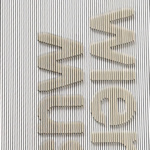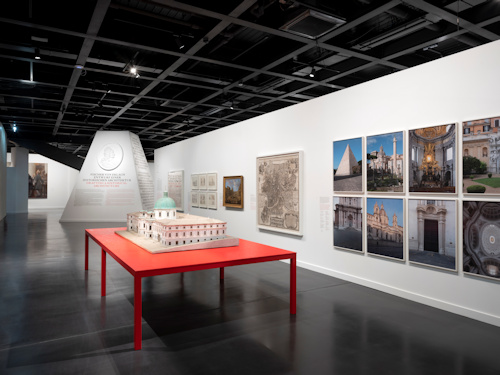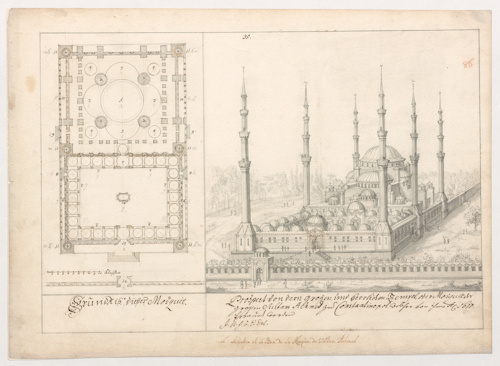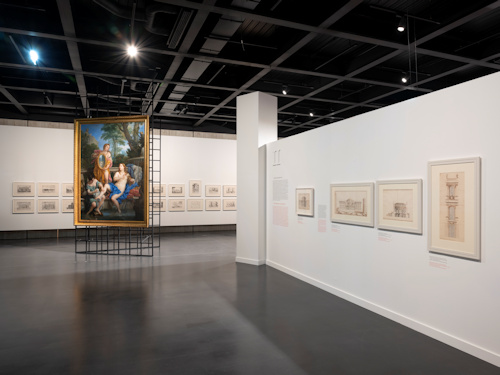
Building one Baroque masterpiece might be down to luck. Building several suggests serious talent. Especially when your customer is as demanding as the Holy Roman Emperor. A Wien Museum exhibition shines a light on the genius that was architect Johann Bernhard Fischer von Erlach.
- Traces his remarkable architectural achievements
- Also looks at his art-influenced approach
- Drawings, models, photos and more
- Includes his 1721 illustrated guide to historical architecture
- Cooperation with the Salzburg Museum
- Runs Feb 1 – Apr 28, 2024
- See also:
- Wien Museum Karlsplatz
- Current & future architecture exhibitions
Historical architecture

(Entrance view of the Fischer von Erlach exhibition; press photo © Werner Feiersinger)
Browse any postcard display in a Vienna souvenir shop, and a few locations appear repeatedly.
Schönbrunn Palace, of course. The arena of the Spanish Riding School. The astonishing Karlskirche church. Perhaps the breathtaking magnificence that is the former court library and now the State Hall of the National Library.
What those buildings and other such creations elsewhere in Europe all have in common is an architect, specifically Johann Bernhard Fischer von Erlach (1656–1723). A man with a name almost as long as his architectural CV.
The first special exhibition at the reopened Wien Museum introduces us to Fischer’s work, allowing us to grasp the magnitude of his talent.
The architect’s particular skill was to incorporate echoes of antiquity within notably contemporary and innovative designs. A perfect combination when creating buildings for archbishops, emperors and nobles.
After all, such patrons of the arts liked to see themselves positioned as a continuation of ancient lines and venerable histories.

(Johann Bernhard Fischer von Erlach, The Sultan Achmed Mosque in Istanbul, before 1712, pen and ink drawing, National and University Library Zagreb © National and University Library Zagreb)
That ability seems to stem from a combination of characteristics within Fischer himself. He had a clear artistic bent, for example, beginning life as a sculptor.
As such, Fischer’s works can be interpreted in terms of remarkable artistic ambition in the way they use shapes and space.
Equally, Fischer had an excellent grasp of historical architecture…unencumbered by bias or a false sense of any one culture’s superiority.
So our architect could take the best of the world, pass it through the filter of his own genius and sculptural talents, add in creativity and…voilà…we have buildings that stand the test of time and taste.
Fischer left his mark in more than just stone, though.
In 1721, for example, he published what was then the world’s first illustrated guide to the history of global architecture. A publication that influenced the cultural memory in a way that is still felt today.
The copperplates from those books form a notable centrepiece of the exhibition, where drawings, prints, paintings, models and more take us through nine broadly chronological chapters.
The exhibition also includes large format photos by Werner Feiersinger, whose modern perspective opens up new lines of interpretation and understanding of Fischer’s intentions.

(Architectural drawings in the exhibition; press photo © Werner Feiersinger)
The journey begins in Rome, where Fischer completed his education as a sculptor and soaked up the artistic influences of the time.
Then it takes us through early commissions, time as the quasi court architect in Salzburg and back to Vienna, ending with his final masterpieces (of which the Karlskirche was the crowning glory).
The result is rather breathtaking.
First and foremost, we have an architectural exhibition, plotting the evolution of an architect responsible for some of Europe’s most memorable Baroque beauties.
We see how Trajan’s Column in Rome might have inspired the Karlskirche equivalents. We can flip through a copy of Fischer’s sketchbook. And browse preliminary, unfulfilled designs for Schönbrunn Palace.
But we also have an art exhibition, thanks to the numerous drawings and paintings.
And we have a history exhibition, opening our eyes to Baroque Vienna and recapturing scenes and constructions lost to posterity.
So we view, for example, giant maps of the city and illustrations of the temporary buildings that dominated Fischer’s early career: triumphal arches for the return of Joseph I after being crowned Roman-German King or funeral scaffolding for the same emperor on his untimely death from smallpox in 1711.
All-in-all…a true treat.
Dates, tickets & tips
View the evidence of Fischer von Erlach’s architectural genius from February 1st to April 28th, 2024.
Although the Wien Museum’s permanent exhibition on the same site is free to visit, special exhibitions like this one require a ticket (note that those under 19 still pay nothing).
Should you wish to see Fischer von Erlach’s work in all its three-dimensional glory, you just need to go out onto the Wien Museum’s terrace. The Karlskirche is next door.
How to get there
Follow the travel tips on the main Wien Museum Karlsplatz page.
Address: Karlsplatz 8, 1040 Vienna